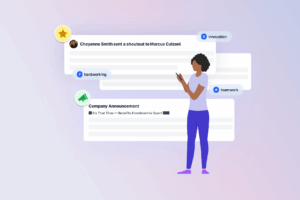Share
Considering starting a workplace giving program? The outward benefits—including positive PR and increased brand reputation—may be obvious, but many employers are surprised by the positive effects that are visible in the day-to-day operation of the company. The boost in morale and team spirit can contribute to overall improved company culture at the grassroots level, but you’ll need to plan ahead in order to maximize the positive impact of your program.
Here are a few of the internal benefits that are possible with workplace giving:
Improved relations with customers
The most obvious impact of good publicity is an influx of new customers, but there can also be major benefits when existing customers see your company in a more positive light. Instead of simply providing a product or service on a transactional basis, your company becomes more relatable—even inspiring a sense of brand loyalty—as you positively impact your community. When customers associate your business with the charitable causes you support, they bring a more positive attitude to interaction with account managers, sales, service, and other representatives.
Added tool for recruiting and retention
Now more than ever, workers expect to have a positive and meaningful impact on the world. A workplace giving program is one tool for giving the entire company a sense of purpose and a worthy cause beyond the success of the business. As the charitable cause becomes part of your company culture, that commitment should be emphasized in your recruiting and onboarding efforts. Applicants and new hires who respond positively to the workplace giving program will also tend to be employees who are motivated to exceed the minimum expectations.
Increased employee engagement
Charitable giving will get more employees involved in the company, other than just work. With workplace giving and related projects, you can provide challenges and opportunities outside of the daily routine and expectations. Schedules may not allow for all employees to volunteer, but you can still encourage employees to participate in creative projects and fundraising drives. By collaborating with new faces from other departments, employees will forge new connections for a more resilient company.
Improved morale and energy levels
Most managers and HR professionals would love to have a positive and self-motivated workforce, but the ideal is easier to imagine than to achieve. Experienced employees will respond skeptically when effusively perky managers raise the bar for productivity. With a workplace giving program, you can be genuinely excited about goals that aren’t directly related to company success. Genuine enthusiasm and goodwill are more likely to spread through the workforce, especially if a diverse committee of employees selected the charitable cause.
Motivation for collaboration and innovation
Both when you’re setting up your workplace giving program, and also when you’re implementing the program, you should be careful to include a variety of employees. Pull individuals from different departments without including too many managers. When committees are top-heavy with managers, subordinates may have difficulty voicing their opinions. If you’ve been collecting the right data in employee reviews, then you should easily identify the staff with untapped potential. When promotion opportunities aren’t frequently available, special projects like a giving program allow employees to develop new skills.
Efficient implementation with Netchex
Some managers are concerned that charitable programs can take too much focus away from the daily operation of the business. It’s true that if employees need to schedule volunteer hours or distribute in-kind donations, then the charitable program can take more and more work hours to sustain. Fortunately, programs like Netchex’s Helping Hands streamline the process to collect and manage payments from individual employees. Using payroll deductions to collect donations is the least disruptive way to involve as many employees as possible, and for many charitable organizations, donations are often more helpful than in-person volunteer hours and material collections like canned food drives. When your program is first adopted and implemented, one-time or recurring donations give employees a way to participate without taking additional time away from work.
Build strong company leadership
When you decide to tackle Corporate Social Responsibility issues, a number of rank-and-file employees, as well as middle managers, will display new abilities for leadership. A charitable giving program creates opportunities for flexibility and innovation that rarely arise in many workplaces. Pay attention to those team members who seem to understand and articulate the positive impact your company can make, because those skills may translate well into leadership and sales applications. It’s difficult to identify new talent when your processes are rigidly structured, but CSR work and charitable programs necessarily encourage expansive and innovative thinking. When you’re giving back to the community with a workplace giving program, you’re also strengthening your company, as well as developing and rewarding your employees.
For a workplace giving program that enables you to grow your company, expand your reach, and better your employees, check out our new Helping Hands feature:
Related articles

The Real ROI of Streamlining HR and Payroll

Tasks & Workflows: Innovating Automation for HR

How to Build a Scalable HR Stack for a 50–200 Person Team

